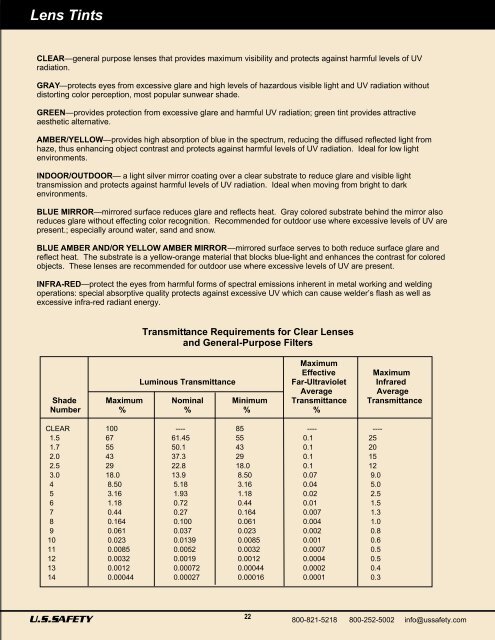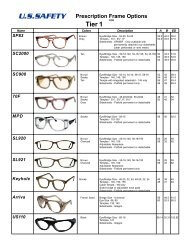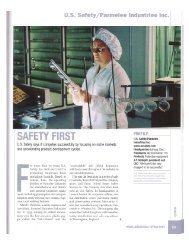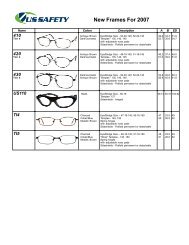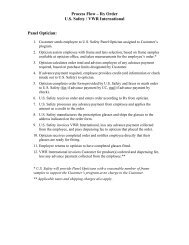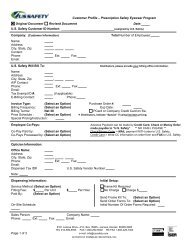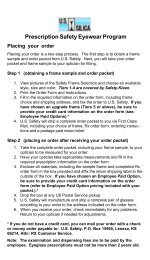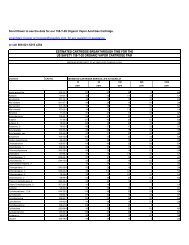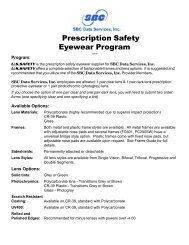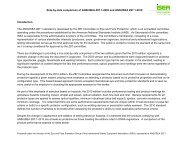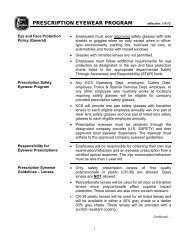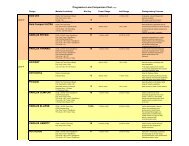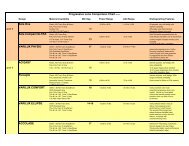Protective Eyewear - US Safety
Protective Eyewear - US Safety
Protective Eyewear - US Safety
You also want an ePaper? Increase the reach of your titles
YUMPU automatically turns print PDFs into web optimized ePapers that Google loves.
Lens Tints<br />
CLEAR—general purpose lenses that provides maximum visibility and protects against harmful levels of UV<br />
radiation.<br />
GRAY—protects eyes from excessive glare and high levels of hazardous visible light and UV radiation without<br />
distorting color perception, most popular sunwear shade.<br />
GREEN—provides protection from excessive glare and harmful UV radiation; green tint provides attractive<br />
aesthetic alternative.<br />
AMBER/YELLOW—provides high absorption of blue in the spectrum, reducing the diffused reflected light from<br />
haze, thus enhancing object contrast and protects against harmful levels of UV radiation. Ideal for low light<br />
environments.<br />
INDOOR/OUTDOOR— a light silver mirror coating over a clear substrate to reduce glare and visible light<br />
transmission and protects against harmful levels of UV radiation. Ideal when moving from bright to dark<br />
environments.<br />
BLUE MIRROR—mirrored surface reduces glare and reflects heat. Gray colored substrate behind the mirror also<br />
reduces glare without effecting color recognition. Recommended for outdoor use where excessive levels of UV are<br />
present.; especially around water, sand and snow.<br />
BLUE AMBER AND/OR YELLOW AMBER MIRROR—mirrored surface serves to both reduce surface glare and<br />
reflect heat. The substrate is a yellow-orange material that blocks blue-light and enhances the contrast for colored<br />
objects. These lenses are recommended for outdoor use where excessive levels of UV are present.<br />
INFRA-RED—protect the eyes from harmful forms of spectral emissions inherent in metal working and welding<br />
operations: special absorptive quality protects against excessive UV which can cause welder’s flash as well as<br />
excessive infra-red radiant energy.<br />
Transmittance Requirements for Clear Lenses<br />
and General-Purpose Filters<br />
Maximum<br />
Effective Maximum<br />
Luminous Transmittance Far-Ultraviolet Infrared<br />
Average Average<br />
Shade Maximum Nominal Minimum Transmittance Transmittance<br />
Number % % % %<br />
CLEAR 100 ---- 85 ---- ----<br />
1.5 67 61.45 55 0.1 25<br />
1.7 55 50.1 43 0.1 20<br />
2.0 43 37.3 29 0.1 15<br />
2.5 29 22.8 18.0 0.1 12<br />
3.0 18.0 13.9 8.50 0.07 9.0<br />
4 8.50 5.18 3.16 0.04 5.0<br />
5 3.16 1.93 1.18 0.02 2.5<br />
6 1.18 0.72 0.44 0.01 1.5<br />
7 0.44 0.27 0.164 0.007 1.3<br />
8 0.164 0.100 0.061 0.004 1.0<br />
9 0.061 0.037 0.023 0.002 0.8<br />
10 0.023 0.0139 0.0085 0.001 0.6<br />
11 0.0085 0.0052 0.0032 0.0007 0.5<br />
12 0.0032 0.0019 0.0012 0.0004 0.5<br />
13 0.0012 0.00072 0.00044 0.0002 0.4<br />
14 0.00044 0.00027 0.00016 0.0001 0.3<br />
U.S.SAFETY<br />
22<br />
800-821-5218 800-252-5002 info@ussafety.com


